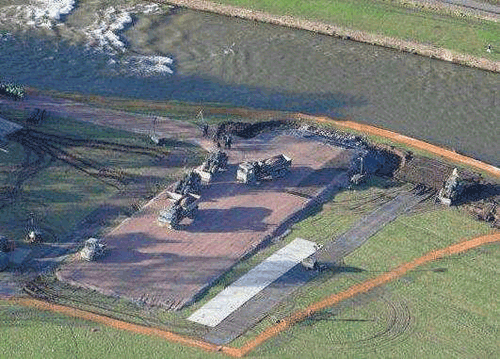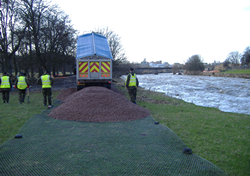In November 2009 the north west of England experienced widespread flooding. In the town of Workington, one road bridge collapsed and the other was deemed unsafe. The town was divided in two. The Royal Engineers were commissioned to build a temporary footbridge. The Engineers required design guidance on stabilisation and delivery of geogrids within 24 hours.
 |
The banks of the River Derwent consist of sandy clay soil with poor load bearing properties. By constructing the abutment bank seat supports, as well as the bridge assembly platform, using Tensar TriAx™ geogrid and locally sourced stone, the time and cost involved in any other stabilisation methods and support services were avoided.
Referring to the bridge abutments, Captain Caroline Graham-Brown of the Royal Engineers commented, "Normally the bridge would be built on existing abutments or temporary abutments on a river bank. In this case the saturated topsoil was stripped down to the sandy clay below and the platform was built up using the TriAx™ geogrid. A platform was built with multiple layers of TriAx™ geogrid and a minimum of 400mm of DOT type 1 sub-base aggregate."
 |
 |
A longer version of this project was published here in early December 2009, just two weeks after the emergency project conducted. You can read that story here.
PROJECT TEAM
Contractor: Royal Engineers
Consultant: Royal Engineers
Client: Allerdale Borough Council
RELATED LINKS
Tensar profile on Geosynthetica
Tensar International Rolls Out TriAx™ Geogrids in the Americas
SUBMIT your project photos and stories to Geosynthetica’s editorial director. Contact Chris Kelsey at chris@geosynthetica.net.











